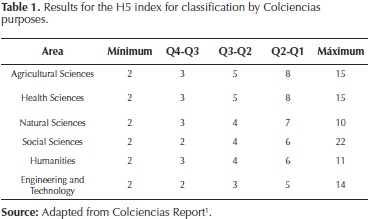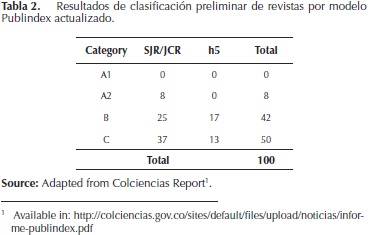Services on Demand
Journal
Article
Indicators
-
 Cited by SciELO
Cited by SciELO -
 Access statistics
Access statistics
Related links
-
 Cited by Google
Cited by Google -
 Similars in
SciELO
Similars in
SciELO -
 Similars in Google
Similars in Google
Share
Ingeniería e Investigación
Print version ISSN 0120-5609
Ing. Investig. vol.37 no.1 Bogotá Jan./Apr. 2017
Editorial
Report about the preliminary results of the National Bibliographic Index - Publindex
Continuing with the call for indexing Colombian Specialised Scientific Journals - Publindex, Colciencias recently published a report about its development1. This editorial note from Engineering and Research Journal aims to show the readers some of the results from the process mentioned before, especially because such report has had limited access and, in general terms, authors do not know about it.
Among the outstanding results, it is said that there are 644 national journals, from which 551 were endorsed by their institutions. Among the 551 endorsed journals, 344 met the six requirements that, according to Colciencias, define the editorial quality of a serial publication. The six criteria outlined by Colciencias were:
- The percentage of authors from the publishing institution, is less or equal to 50%.
- The editor publishes, at most, one article yearly in the same journal he edits.
- At least 80% of the members of the editorial-scientific committee have external affiliation to the institution.
- At least 50% of the members of the editorial or scientific committee are recognised by Colciencias (for researchers that are part of Colombian institutions) or have a postgraduate certification and an H5 index higher than 2 (for researchers that are not part of Colombian institutions).
- At least 60% of the peer reviewers that support the evaluation processes are neither part of the editorial/ scientific committee, nor part of the publishing institution.
- The journal meets at least one of the following requirements: a) To be included in at least one citation index- IBC (JCR from Wob of Science/ SJR from Scimago). b) To be included in at least one bibliographic index - IB. c) To be included in at least a bibliographic database with a Selection Scientific Committee. In any of the three cases, the databases should be part of the current version of the updated list from the Indexing and Abstracting Systems.
The criteria above aim for selecting the journals with two clear purposes: for the affiliation of the editorial team to be external to the institution, and for the journal to be in certain citation databases, especially Scopus and Web of Science.
Among the 551 endorsed journals, 70 are linked to the JCR or SJR index, reason why they are part of the Phase III of the process. According to the assessment carried out by Colciencias, 67 journals (19,48% out of 551) meet all the requirements that were established in the current Publindex model. Afterwards, the H5 index is determined (Hirsch, 2005) by using the Publish or Perish tool developed by Anne W. Harzing (Harzing, 2007). It allows to establish a journal ranking similar to the one presented for the national Engineering Journals by Pavas, (2016a), but applied to the six big areas of knowledge defined by Colciencias. The results are shown in Table 1.
The results for the Colombian Engineering Journals reported by Pavas (2016a) can be used as a comparison. Even if the results are not exactly the same, they are similar and the differences can be due to the method used to make the calculations, the observation windows, and the updating of quotations found later on.
With the H5 index, Colciencias proceeds to propose a preliminary classification for the journals, including in the categories B and C, those journals that are between the first and second quartile from H5, in their respective area, only if they do not have indicators in the SJR and JCR index. The results are shown in Table 2.
The report proposes adjustments in the threshold of the six criteria used to assess the editorial quality of the journal, which, eventually, may let include some journals in the classification of national journals. As a summary, 100 journals from 551 that are going to be categorized by Colciencias will be included, or seen from another point of view, 451 (81,85%) are going to be excluded from the National Bibliographic Index.
The report closes with what Colciencias refers to as 'Objectives set to improve the quality of scientific publications: Strategies and actions for strengthen national journals'. I invite the readers to review the document written by Colciencias and to reflect upon the following:
- What importance does Publindex have abroad? How is Publindex considered by the repositories and the tools to generate bibliometric indexes to define the indicators of each journal?
- How can the exclusion of publications from the National Bibliographic Index can help foster and drive the national scientific communication?
- Is it appropriate to assess the national journals, which main audience is located within the country and the Spanish speaking countries as it is shown by Pavas (2016c), for the I&I (Engineering and Research) Journals, throughout the JCR y SJR indexes, and excluding regional repositories such as SciELO, Redalyc and Google Scholar? The current model allows the inclusion of journals that have H5 indicators from Google Scholar, but they are not allowed to reach the A1 and A2 categories.
- If the national journals are not included in the National Bibliographic Index, and an important part of the results from national research are publishable just in those publications (due to their local nature), is not Colciencias putting at risk the visibility of the results from national researchers when excluding national journals?
- If the journals with foreign affiliation are not necessarily interested in publishing the results from their research that are relevant for Colombia, the researchers would be forced to aim their research to those topics that are accepted by such journals. In that case, is Colciencias fulfilling its function of fostering knowledge and national development by supporting the publication in foreign journals in topics that are more relevant for other countries?
The consequences of the new Publindex model, and the outlines that are proposed in terms of the policy for fostering the national scientific publications can have as consequences: To affect the classification and rating of researchers and research groups as shown in Pavas (2015a; 2016b), which will bring an even bigger reduction of the resources available for Young researchers and national PhDs, not just for the Universidad Nacional de Colombia, but for all the national institutions; the journals excluded by Publindex would be at risk of affecting their sustainability and the institutional support they get; the visibility of the national academic production will not necessarily have the effect Colciencias is expecting because the journals with foreign affiliation do not have the same interest in research developed in Colombia.
Undoubtedly, the continuous quality improvement of any process is part of any organization that has among its aims constant updating and sustainability. It is also true that the comparison throughout indicators allows the identification of issues and opportunities for improvement. What should not be left behind is that such comparison needs to recognize its own context, the reach and mission of those who evaluate, as well as, its possibilities and resources.
The Engineering and Research Journal thanks all the authors, reviewers, and readers for keeping your interest in knowledge dissemination, as well as for sharing it through this open space. You can be sure that the Editorial Team will maintain their efforts to display and position your contributions in all repositories and indexes. We hope, again, that this issue is of your interest.
ANDRÉS PAVAS
Editor-in-chief Revista Ingeniería e Investigación
Assistant Professor. Universidad Nacional de Colombia
Bogotá, Colombia
Notas
1 Available in: http://colciencias.gov.co/sites/default/files/upload/noticias/informe-publindex.pdf.
Referencias
Pavas, A. (2015a). Editorial. Ingeniería e Investigación. Vol. 35(1). 3-4 Pavas, A. (2015b). Ranking de revistas científicas colombianas: el caso de ingeniería. Ingeniería e Investigación. 35(3). 3-4.
Pavas, A. (2016a). Estado del indicador h5 en revistas colombianas de ingeniería. Ingeniería e Investigación. 36(1). 3-5.
Pavas, A (2016b). Resultados de la medición de grupos de investigación de la Universidad Nacional de Colombia. Ingeniería e Investigación. 36(2). 3-5.
Pavas, A (2016c). Visibilidad de la Revista Ingeniería e Investigación. Ingeniería e Investigación. 36(3). 3-5.
Hirsch, J. E. (2005). An index to quantify an individual's scientific research output. Proceedings of the National Academy of Sciences of the United States of America, 102 (46), 16569-16572. Recuperado el 29 de marzo de 2017, de http://arxiv.org/abs/physics/0508025.
Harzing, A.W. (2007) Publish or Perish. Consultado el 29 de marzo de 2017, de: http://www.harzing.com/pop.htm.
Pavas, A. (2015a). Editorial. Ingeniería e Investigación. Vol. 35(1). 3-4 [ Links ]
Pavas, A. (2015b). Ranking de revistas científicas colombianas: el caso de ingeniería. Ingeniería e Investigación. 35(3). 3-4. [ Links ]
Pavas, A. (2016a). Estado del indicador h5 en revistas colombianas de ingeniería. Ingeniería e Investigación. 36(1). 3-5. [ Links ]
Pavas, A (2016b). Resultados de la medición de grupos de investigación de la Universidad Nacional de Colombia. Ingeniería e Investigación. 36(2). 3-5. [ Links ]
Pavas, A (2016c). Visibilidad de la Revista Ingeniería e Investigación. Ingeniería e Investigación. 36(3). 3-5. [ Links ]
Hirsch, J. E. (2005). An index to quantify an individual's scientific research output. Proceedings of the National Academy of Sciences of the United States of America, 102 (46), 16569-16572. Recuperado el 29 de marzo de 2017, de http://arxiv.org/abs/physics/0508025. [ Links ]
Harzing, A.W. (2007) Publish or Perish. Consultado el 29 de marzo de 2017, de: http://www.harzing.com/pop.htm [ Links ]











 text in
text in 




